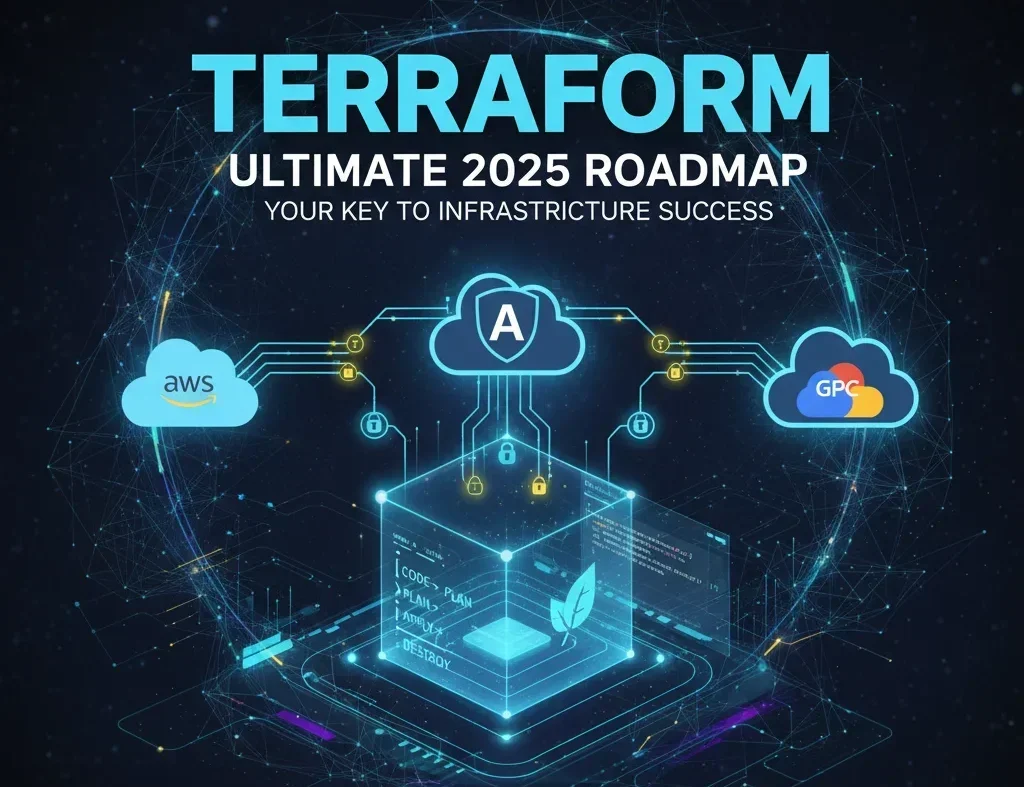Table of Contents
Why Terraform is Your Key to Infrastructure Success in 2025
Imagine you’re tasked with deploying a multi-cloud application across AWS, Azure, and GCP in a matter of hours, not days. Sounds daunting, right? In 2025, Terraform Infrastructure as Code makes this a reality. Terraform, HashiCorp’s open-source tool, empowers developers and DevOps professionals to automate and manage infrastructure with unparalleled efficiency. With a thriving community boasting 338K GitHub stars and 40K Discord members, Terraform is the go-to solution for scalable cloud deployments.
This blog unveils the ultimate Terraform Roadmap for 2025, a step-by-step guide to mastering Terraform Automation. Whether you’re a beginner dipping your toes into Terraform CLI Basics or a seasoned pro exploring Terraform Cloud and Enterprise Features, this roadmap is your path to success. Packed with practical tips, real-world examples, and Terraform Best Practices, this 2,000-word guide will transform how you manage infrastructure. Let’s get started!
What is Terraform and How Does It Work?
Terraform is an open-source Infrastructure as Code tool that lets you define, provision, and manage infrastructure using code. Unlike manual setups or scripts, Terraform’s declarative approach ensures consistency and repeatability across cloud providers like AWS, Azure, and GCP.
How Terraform Works: The Terraform Roadmap begins with understanding its core workflow:
- Write: Craft infrastructure configurations in HashiCorp Configuration Language (HCL) or JSON.
- Plan: Run Terraform plan to preview changes before applying them.
- Apply: Execute Terraform apply to create or update resources.
- Destroy: Use terraform destroy to tear down infrastructure when it’s no longer needed.
Here’s a simple HCL example to provision an AWS EC2 instance:
resource "aws_instance" "example" {
ami = "ami-0c55b159cbfafe1f0"
instance_type = "t2.micro"
}
According to TheNewStack, 90% of enterprises in 2025 use IaC tools like Terraform for cloud deployments, highlighting its dominance in Terraform Automation. Its ability to manage multi-cloud environments makes it a must-have skill for DevOps teams.
What Are the Prerequisites to Learn Terraform?
Before diving into the Terraform Learning Path, ensure you have these foundational skills:
- Cloud Basics: Familiarity with AWS, Azure, or GCP services.
- Version Control: Experience with Git for managing Terraform Configuration Files.
- Command-Line Skills: Comfort with terminal commands for Terraform CLI Basics.
- Programming Concepts: Knowledge of variables and conditionals (HCL is beginner-friendly but shares programming logic).
No IaC experience? Don’t worry! Terraform’s intuitive syntax is accessible, and these prerequisites will fast-track your learning.
Step-by-Step Terraform Roadmap for 2025
This Terraform Roadmap guides you from beginner to expert, covering Terraform Automation, Terraform Best Practices, and advanced topics like Terraform Modules and State Management. Let’s break it down into actionable steps.
Step 1: Master Terraform CLI Basics
The Terraform Command Line Interface (CLI) is your entry point. Key commands include:
- terraform init: Initializes a working directory.
- terraform plan: Previews infrastructure changes.
- terraform apply: Provisions or updates resources.
- terraform destroy: Removes managed resources.
Tip: Practice in a sandbox like AWS Free Tier or Azure’s free account to avoid costs.
Example: A junior DevOps engineer at a startup used terraform init and terraform apply to deploy a VPC in AWS, slashing setup time from hours to minutes.
Step 2: Understand Terraform Providers and Configuration Files
Terraform Providers are plugins that connect Terraform to cloud APIs (e.g., AWS, Azure, GCP). Terraform Configuration Files (.tf files) define your infrastructure.
Actionable Steps:
- Explore the Terraform Registry for provider documentation.
- Start with simple resources, like an S3 bucket or virtual machine.
- Use variables for reusable code:
variable "region" {
default = "us-east-1"
}
provider "aws" {
region = var.region
}
Fact: The Terraform Registry hosts over 1,000 providers, supporting everything from Kubernetes to DNS services.
Step 3: Leverage Terraform Modules for Reusable Infrastructure
Terraform Modules let you package and reuse code, making infrastructure scalable. For instance, a module can define a standard VPC setup reusable across projects.
How to Create Modules:
- Build a module directory with .tf files.
- Reference it in your main configuration:
module "vpc" {
source = "./modules/vpc"
cidr_block = "10.0.0.0/16"
}
Case Study: A fintech company cut deployment time by 40% by using Terraform modules to standardize Kubernetes clusters across AWS and GCP.
Step 4: Master Terraform State and Variables Management
Terraform State Management tracks infrastructure state in a terraform.tfstate file. Mismanaging state can cause configuration drift or conflicts.
Best Practices:
- Store state remotely (e.g., S3 or Terraform Cloud) for team collaboration.
- Use terraform state commands to inspect or modify state.
- Define variables for flexibility:
variable "instance_count" {
default = 2
}
resource "aws_instance" "app" {
count = var.instance_count
ami = "ami-0c55b159cbfafe1f0"
instance_type = "t2.micro"
}
Tip: Use Terraform Workspaces to manage multiple environments (dev, staging, prod) within one configuration.
Step 5: Explore Terraform Cloud and Enterprise Features
Terraform Cloud provides a managed platform for state storage, collaboration, and automation. Key features include:
- Remote Backends: Securely store state files.
- Policy as Code: Enforce compliance with Sentinel policies.
- Run Triggers: Automate workflows across projects.
Example: A retail company used Terraform Cloud to streamline multi-team deployments, reducing errors by 25% with automated policy checks.
Step 6: Adopt Terraform Best Practices for Automation
To ensure scalable infrastructure, follow these Terraform Best Practices:
- Version Control: Store .tf files in Git for auditing.
- Modularize Code: Break configurations into reusable modules.
- Test Configurations: Use tools like terratest for automated testing.
- CI/CD Integration: Pair Terraform with GitHub Actions or Jenkins.
Statistic: A 2025 DevOps survey found that CI/CD with Terraform speeds up deployments by 30%.
Step 7: Deploy and Test Terraform Configurations on Cloud Platforms
Test your skills in real-world scenarios:
- Deploy a multi-tier app (e.g., web server + database) on AWS.
- Validate configurations with terraform validate.
- Use Terraform Testing and Validation Strategies like terratest or kitchen-terraform.
Scenario: A SaaS provider used Terraform to deploy a Kubernetes cluster on GCP, cutting provisioning time from days to hours.
Step 8: Tackle Complex Setups and Multi-Cloud Management
Can Terraform manage complex infrastructure setups like Kubernetes? Yes, its Kubernetes provider supports clusters, namespaces, and resources.
Is Terraform suitable for multi-cloud infrastructure management? Absolutely. Terraform’s provider ecosystem enables seamless management across AWS, Azure, and GCP. For example, you can define a hybrid setup with AWS EC2 instances and Azure SQL databases in one configuration.
FAQs
What is Terraform and how does it work?
Terraform is an IaC tool that automates infrastructure provisioning using declarative code. It works by defining resources in HCL, planning changes, and applying them to cloud platforms.
Should beginners learn Terraform CLI or CDK for Terraform?
Start with Terraform CLI for core skills; CDK suits advanced users with programming expertise.
How to manage Terraform state and variables effectively?
Use remote backends and variables for scalability and collaboration.
What are the prerequisites to learn Terraform?
Basic cloud knowledge, Git proficiency, and CLI skills are key.
Can Terraform manage complex infrastructure setups like Kubernetes?
Yes, Terraform’s Kubernetes provider handles clusters and resources.
How to use Terraform modules for reusable infrastructure?
Create modular code and reference it to avoid repetition.
What are the core workflows of Terraform?
Write, plan, apply, and destroy form the foundation of Terraform Automation.
Are Terraform workspaces essential for collaboration?
Workspaces help but aren’t mandatory; Terraform Cloud is often preferred.
How to get started with Terraform for infrastructure management?
Install Terraform, set up a cloud account, and write a .tf file to provision a resource.
What are the best Terraform practices for automation?
Use version control, modularize code, store state remotely, and integrate with CI/CD.
Is Terraform suitable for multi-cloud infrastructure management?
Terraform excels in multi-cloud setups with its provider ecosystem.
How to deploy and test Terraform configurations on cloud platforms?
Validate with Terraform validate and test with tools like terratest.
Conclusion: Start Your Terraform Roadmap Today
The Terraform Roadmap for 2025 is your guide to mastering Terraform Infrastructure as Code. From Terraform CLI Basics to Terraform Cloud and Enterprise Features, this roadmap equips you to automate infrastructure and excel in multi-cloud environments. Start with a simple .tf file, join the roadmap.sh community, and take the first step toward becoming a Terraform expert in 2025!
for more blogs like this visit careerswami.com


















